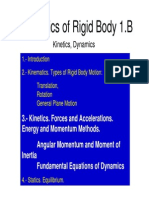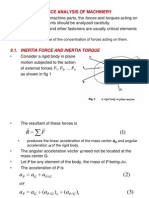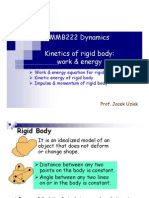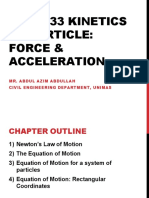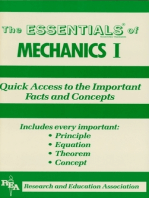General Plane Motion of Rigid Bodies
General Plane Motion of Rigid Bodies
Uploaded by
Arvin NaborCopyright:
Available Formats
General Plane Motion of Rigid Bodies
General Plane Motion of Rigid Bodies
Uploaded by
Arvin NaborCopyright
Available Formats
Share this document
Did you find this document useful?
Is this content inappropriate?
Copyright:
Available Formats
General Plane Motion of Rigid Bodies
General Plane Motion of Rigid Bodies
Uploaded by
Arvin NaborCopyright:
Available Formats
General Plane Motion of Rigid Bodies Our approach will be to consider a rigid body as a special case of a system of particles.
A rigid body is a large numbers of particles, rigidly connected. We can use the results we have already obtained for the motion of systems of particles. Specifically, we will use these 2 equations that we have already derived for a system of particles: F = maG where
F
is the resultant of the external forces acting on the system m is the total mass of the system of particles aG is the acceleration of the mass center, G, of the system of particles MG = dHG/dt where
MG
is the moment resultant of the external forces about the mass center of the system HG is the angular momenta of all of the particles of the system about G These equations are very general: they apply to any system of particles in a Newtonian frame. We will now apply them to a rigid body in plane motion. With a bit of work we can derive the following equation: dHG/dt = IG In english this equation says: "The rate of change of the angular momentum about the mass center of a rigid body in plane motion is equal to the product of the centroidal mass moment of inertia and the angular acceleration of the body"
So we have for a rigid body in plane motion we have these 2 equations: F = maG MG = IG where m is the mass of the rigid body aG is the acceleration of the mass center (aG is the same as a with the bar on top. Recall that quantities that refer to the mass center often have a bar on top.) IG is the moment of inertia of the rigid body about its mass center is the angular acceleration of the rigid body (IG is the same as I with the bar on top. Recall that quantities that refer to the mass center often have a bar on top.)
Note: These 2 equations have the following restrictions (that came out in the derivation which we skipped): They are restricted to the plane motion of rigid bodies, that is, to a motion in which each particle of the body remains at a constant distance from a fixed reference plane. 2. The rigid bodies considered will consist only of plane slabs and of bodies which are symmetrical with respect to the reference plane.
1.
Approach for solving problems involving the plane motion of rigid bodies: The approach to solving problems involving rigid bodies is essentially the same as the approach we used for particles. 1. Draw the FBD of the rigid body. (figure a below) 2. Set this FBD equal to the inertia vector diagram. (figure b below) In the case of rigid bodies this IVD will show a single effective force, maG, and a single effective couple, IG . (Recall that for particles we did not have any effective moments, just the effective forces.
3. Apply the two (vector) equations above in the three component directions. 4. For a 2 dimensional problem we would have: 5. Fx = maGx 6. Fy = maGy
MGz = IG So we can think of the motion of a rigid body being broken into two parts: a pure translation with the mass center, maG, and a pure rotation, IG.
7. 8.
Rolling motion
You might also like
- Endothermic Reactions vs. Exothermic Reactions Worksheet Process System Exo Endo ExplanationDocument3 pagesEndothermic Reactions vs. Exothermic Reactions Worksheet Process System Exo Endo ExplanationFelix Jose83% (6)
- Dynamics Chapter 7Document118 pagesDynamics Chapter 7Hisyammudin RoslanNo ratings yet
- Plane Kinetics of Rigid Bodies: Chapter OutlineDocument104 pagesPlane Kinetics of Rigid Bodies: Chapter OutlineMike RodeloNo ratings yet
- Planar Kinetic Equations of Motion: Moment of Inertia Parallel-Axis TheoremDocument61 pagesPlanar Kinetic Equations of Motion: Moment of Inertia Parallel-Axis TheoremEvan Hossein PournejadNo ratings yet
- Planar Kinetics of A Rigid Body: Force and AccelerationDocument25 pagesPlanar Kinetics of A Rigid Body: Force and Accelerationzahraa BahjatNo ratings yet
- Theory: When A Rigid Body With A Fixed Pivot Point O, Is Acted Upon by A ForceDocument2 pagesTheory: When A Rigid Body With A Fixed Pivot Point O, Is Acted Upon by A ForceNordiana IdrisNo ratings yet
- Lecture Slides (Chapter 5)Document13 pagesLecture Slides (Chapter 5)syed najamNo ratings yet
- Week 11 - Plane Motion of Rigid Body - Force and AccelerationDocument15 pagesWeek 11 - Plane Motion of Rigid Body - Force and AccelerationNoel Himolatan Bolair Jr.No ratings yet
- 2D Rigid Body Dynamics Equations of MotionDocument8 pages2D Rigid Body Dynamics Equations of Motionjehan11No ratings yet
- Topik 10: Dinamika Benda Kaku Gaya Dan PercepatanDocument5 pagesTopik 10: Dinamika Benda Kaku Gaya Dan PercepatanDhedhe PrasetyaNo ratings yet
- Planar Kinematics of A: Rigid Body: Force and AccelerationDocument41 pagesPlanar Kinematics of A: Rigid Body: Force and AccelerationahanNo ratings yet
- Mechanics of Rigid BodyDocument21 pagesMechanics of Rigid Bodyhenzel espinaNo ratings yet
- Lect BalancingDocument72 pagesLect BalancingTalha KhanzadaNo ratings yet
- HW 8 AnsDocument14 pagesHW 8 AnsKristin Dikiciyan100% (5)
- Module 2. Work, Energy, and Conservation of EnergyDocument95 pagesModule 2. Work, Energy, and Conservation of Energytiredstudent03No ratings yet
- AP Physics: - Gravity WrapupDocument11 pagesAP Physics: - Gravity WrapupCash Cash CashNo ratings yet
- Lecture L27 - 3D Rigid Body Dynamics: Kinetic Energy Instability Equations of MotionDocument11 pagesLecture L27 - 3D Rigid Body Dynamics: Kinetic Energy Instability Equations of MotionSenya BatchanNo ratings yet
- MMAN2300 Part A Week 4 Lecture SlidesDocument31 pagesMMAN2300 Part A Week 4 Lecture SlidesrollpiggyrollNo ratings yet
- DORB001 - FINAL PROJECT Group 1Document15 pagesDORB001 - FINAL PROJECT Group 1Trina ArmeaNo ratings yet
- Force Analysis of Machinery: 9.1. Inertia Force and Inertia TorqueDocument16 pagesForce Analysis of Machinery: 9.1. Inertia Force and Inertia TorqueaddisudagneNo ratings yet
- Rotational Dynamics II: Rotation About A Fixed AxisDocument11 pagesRotational Dynamics II: Rotation About A Fixed Axisrizal123No ratings yet
- Chapter - 2: Dynamic Force AnalysisDocument39 pagesChapter - 2: Dynamic Force AnalysisMohammed ImranNo ratings yet
- 1.5 Applications of ForceDocument9 pages1.5 Applications of ForceleoflorianNo ratings yet
- Rigid Body DynamicsDocument45 pagesRigid Body DynamicsGertaNo ratings yet
- Kinetics Body Work&Energy Impulse&MomentumDocument26 pagesKinetics Body Work&Energy Impulse&MomentumKano MolapisiNo ratings yet
- Rotational Dynamics I: Angular MomentumDocument14 pagesRotational Dynamics I: Angular Momentumrizal123No ratings yet
- Law 1. Unless A Force Is Applied To A Particle It Will EitherDocument151 pagesLaw 1. Unless A Force Is Applied To A Particle It Will EitherSteve KrodaNo ratings yet
- Kinetics of Rigid BodyDocument32 pagesKinetics of Rigid BodyAdrian AbdillaNo ratings yet
- 7. System of Particles and Rotational Motion_watermarkDocument21 pages7. System of Particles and Rotational Motion_watermarkaryanmohan453No ratings yet
- Kns1633 Kinetics of Particle: Force & Acceleration: Mr. Abdul Azim Abdullah Civil Engineering Department, UnimasDocument47 pagesKns1633 Kinetics of Particle: Force & Acceleration: Mr. Abdul Azim Abdullah Civil Engineering Department, UnimasSek Chin JiNo ratings yet
- Mechanics PortionDocument55 pagesMechanics PortionRupak MandalNo ratings yet
- Rotational Motion Engineering Mechanics IIT KanpurDocument67 pagesRotational Motion Engineering Mechanics IIT KanpurNitin SharmaNo ratings yet
- LP 4 Dynamics of Rigid BodiesDocument18 pagesLP 4 Dynamics of Rigid BodiesKent JazminesNo ratings yet
- Engineering Dynamics Chapter 2Document50 pagesEngineering Dynamics Chapter 2Muhd Salman FarisiNo ratings yet
- Hook's LawDocument4 pagesHook's Law3lix3li232No ratings yet
- Dynamics of Rotational MotionDocument45 pagesDynamics of Rotational MotionAudrry Dela CruzNo ratings yet
- Chapter 6 - Kinetics of Rigid BodyDocument29 pagesChapter 6 - Kinetics of Rigid BodyDivnesh LingamNo ratings yet
- Spring Mass DamperDocument15 pagesSpring Mass DamperAeitesham Ul Huq SubedarNo ratings yet
- Dynamics - Lecture TwoDocument22 pagesDynamics - Lecture TwoKassimNo ratings yet
- Kinetika PartikelDocument60 pagesKinetika PartikelDeo SadewoNo ratings yet
- ميكانيك هندسي 2-4Document21 pagesميكانيك هندسي 2-4DHARMVIR KUMARNo ratings yet
- Centre of MassDocument4 pagesCentre of MassAditya NandaNo ratings yet
- Dynamic Analysis of LinkagesDocument9 pagesDynamic Analysis of LinkagesHimmatSinghNo ratings yet
- System of Particles and Rotational MotionDocument53 pagesSystem of Particles and Rotational MotionANshul Sharma50% (16)
- CopilotDocument23 pagesCopilotvinh.tran2006No ratings yet
- Kinetics (Revision) : MECH 2210: Dynamics & Orbital MechanicsDocument12 pagesKinetics (Revision) : MECH 2210: Dynamics & Orbital MechanicsCandace JohnsonNo ratings yet
- HPhys Unit 04 UBFPM Packet 2012Document16 pagesHPhys Unit 04 UBFPM Packet 2012Kelly O'SheaNo ratings yet
- Dynamics of Machinery Oral Question BankDocument22 pagesDynamics of Machinery Oral Question BankSurajKahateRajputNo ratings yet
- Course Outline: - Week 1, January 4 and 6Document23 pagesCourse Outline: - Week 1, January 4 and 6Michael DemianNo ratings yet
- Statequl PhysicsDocument8 pagesStatequl PhysicsEmmad AnsariNo ratings yet
- May-13-2024 Mon CH 17 Rigid Body Translation, Rotation - ContdDocument22 pagesMay-13-2024 Mon CH 17 Rigid Body Translation, Rotation - ContdAly NaqviNo ratings yet
- Engineering Mechanics Notes2222Document100 pagesEngineering Mechanics Notes2222rajasekharjv100% (1)
- Load & Stress Analysis - 1Document137 pagesLoad & Stress Analysis - 1shafqut hussain ShahNo ratings yet
- ME 563 Chapter 1Document58 pagesME 563 Chapter 1tiratiramodaNo ratings yet
- 6-Moments Couples and Force Couple Systems - PartbDocument39 pages6-Moments Couples and Force Couple Systems - PartbsaishvNo ratings yet
- Chapter 17 Plane Motion of Rigid Bodies: Energy and Momentum MethodsDocument5 pagesChapter 17 Plane Motion of Rigid Bodies: Energy and Momentum MethodsNurul HudaNo ratings yet
- Dynamic LectureDocument99 pagesDynamic LecturePob ParatNo ratings yet
- Simulation of Non Spherical Particles, From Orientation Representation To Computation of Moment of InertiaDocument21 pagesSimulation of Non Spherical Particles, From Orientation Representation To Computation of Moment of InertiafconnerNo ratings yet
- Kinetics of Rigid BodyDocument32 pagesKinetics of Rigid BodyMuhammad FirdawsNo ratings yet
- Full Free Motion of Celestial Bodies Around a Central Mass - Why Do They Mostly Orbit in the Equatorial Plane?From EverandFull Free Motion of Celestial Bodies Around a Central Mass - Why Do They Mostly Orbit in the Equatorial Plane?No ratings yet
- Disaster PreventionDocument4 pagesDisaster PreventionArvin NaborNo ratings yet
- SymbolDocument2 pagesSymbolArvin NaborNo ratings yet
- Economic SectionsDocument13 pagesEconomic SectionsArvin NaborNo ratings yet
- Art FolioDocument1 pageArt FolioArvin NaborNo ratings yet
- Paper MT 2 Brahmastra 12-03-2023Document55 pagesPaper MT 2 Brahmastra 12-03-2023Vaibhav Kumar SinghNo ratings yet
- EGE Flow SensorsDocument104 pagesEGE Flow SensorsEddboi NtelekoaNo ratings yet
- 1 - Piping CBT API 571 QuestionDocument5 pages1 - Piping CBT API 571 QuestionAMALENDU PAULNo ratings yet
- Applsci 10 03025 v2Document10 pagesApplsci 10 03025 v2Cojocaru TiberiuNo ratings yet
- Assignment 2 (334421)Document5 pagesAssignment 2 (334421)AB RehmanNo ratings yet
- Electrolysis: A Guide For GCSE StudentsDocument98 pagesElectrolysis: A Guide For GCSE StudentsNazmi IsaNo ratings yet
- Exercise 1 (6 Points) Oscillations of A Horizontal Elastic PendulumDocument8 pagesExercise 1 (6 Points) Oscillations of A Horizontal Elastic PendulumMohieddine KhailiNo ratings yet
- (2011) Microchemical Journal 97 249 254Document6 pages(2011) Microchemical Journal 97 249 254Ricky S. SilvaNo ratings yet
- Week 2 - Acid-Base Alkalinity Acidity Titration Lab Fall 2022 2Document11 pagesWeek 2 - Acid-Base Alkalinity Acidity Titration Lab Fall 2022 2Vanessa Villegas SanchezNo ratings yet
- 001 - Perforating Gun TechnologyDocument98 pages001 - Perforating Gun TechnologyKARIMA BAUZIZNo ratings yet
- EdtaDocument7 pagesEdtaDonNo ratings yet
- An Introduction To Analytical MechanicsDocument39 pagesAn Introduction To Analytical MechanicsteomondoNo ratings yet
- Refrigeration Note For Marine EngineeringDocument9 pagesRefrigeration Note For Marine EngineeringAbdul MalikNo ratings yet
- NCERT Solutions For Class 11 PhysicsDocument42 pagesNCERT Solutions For Class 11 PhysicsRoy100% (1)
- Honeywell Genetron 134a Technical SpecsDocument18 pagesHoneywell Genetron 134a Technical SpecsLuis Alfonso MartinezNo ratings yet
- 2014 (Mook Et A) - Prospective Applications of Renewable Energy Based ElectrochemicalDocument11 pages2014 (Mook Et A) - Prospective Applications of Renewable Energy Based ElectrochemicalTatiana Sainara Maia FernandesNo ratings yet
- Co TMDocument21 pagesCo TMWondemeneh AsratNo ratings yet
- Module 2.1 - Basic Flow Assurance PDFDocument13 pagesModule 2.1 - Basic Flow Assurance PDFAyuku KidaNo ratings yet
- Sulfur Trioxide and OleumDocument21 pagesSulfur Trioxide and OleumEduardo Magallon100% (1)
- Catalase Lab ActivityDocument6 pagesCatalase Lab Activitysenja fitrianaNo ratings yet
- Growth of MDCK CellsDocument1 pageGrowth of MDCK CellsPing KwanNo ratings yet
- 10 ST Chapter 01Document12 pages10 ST Chapter 01Amit TripathiNo ratings yet
- Layers of The Earth's AtmosphereDocument22 pagesLayers of The Earth's AtmosphereLeah Me GarciaNo ratings yet
- SS621 TUV Testing Report (Full Permission)Document5 pagesSS621 TUV Testing Report (Full Permission)Christiano RodriguezNo ratings yet
- 0 STAR-CCM+ - Reference Guide2012Document8 pages0 STAR-CCM+ - Reference Guide2012triya_vadgamaNo ratings yet
- MULTIPLE CHOICE. Choose The One Alternative That Best Completes The Statement or Answers The Question.Document7 pagesMULTIPLE CHOICE. Choose The One Alternative That Best Completes The Statement or Answers The Question.Nay Lin AungNo ratings yet
- Covered Car Parks Fire Safety Guidance For Electric VehiclesDocument96 pagesCovered Car Parks Fire Safety Guidance For Electric VehiclesDmitryNo ratings yet
- BearingsDocument17 pagesBearingssubodhstudymaterialsNo ratings yet
- Carrie Brooks CV 10-2021-Weebly v2Document2 pagesCarrie Brooks CV 10-2021-Weebly v2api-570067365No ratings yet











